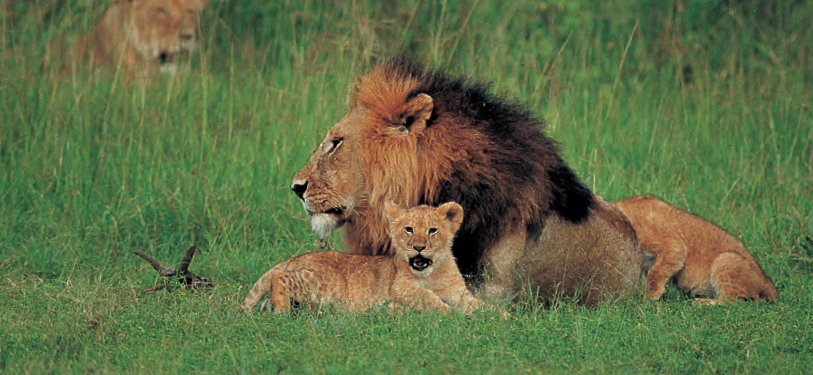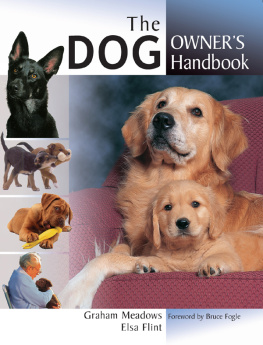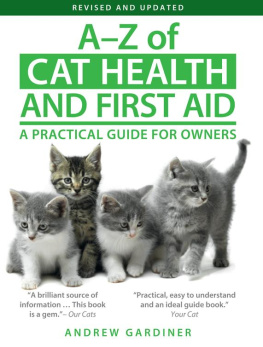Contents
Guide
THE CAT OWNERS HANDBOOK | 
The hunting instinct of your pet cat lies just beneath its domesticated exterior. |

Strange as this may seem, cats and pet rabbits can become good friends your cat may even find its way into the rabbit hutch and laze in the sawdust with its rabbit companions.
THE CAT OWNERS HANDBOOK Graham Meadows
and Elsa Flint | 
Colourwise, mixed-breed littermates need not bear any resemblance to one another. |

Kittens are born with an excellent ability to detect movement not even this well-camouflaged green cricket is safe from the quick-witted kitten.
CONTENTS

Through their interaction with pets, children learn about love, death and respect for other living creatures.

CATS AND PEOPLE
Dogs have masters. Cats have staff. Anon.

Despite their reputation for aloofness, it is not unusual for a cat to head-butt and lick its owner to show affection.
T hose of us who are owned by cats may well subscribe to the theory that humans didnt domesticate the cat at all, but that the cat domesticated itself by walking into, adapting to and (in many cases) taking over peoples lives. With few exceptions the modern domestic cat remains independent and solitary, and has an indefinable wild streak. It gives you a look that implies: I may live in your household, but dont expect me to conform.

Male lions (Panthera leo) within a pride can be particularly tolerant of cubs.
The origin of the domestic cat
A distant ancestor of todays domestic cat may have been Martellis wild cat (Felis lumensis), a species now extinct. It was similar in size to todays small wild cats. About 600,000900,000 years ago it may have given rise to Felis silvestris, from which three distinct types evolved according to the region and environment in which they lived. These were the central European or Forest wild cat (F. silvestris silvestris), the Asiatic desert cat (F. silvestris ornata) and the African wild cat (F. silvestris lybica). The latter inhabited most of Asia and North Africa, and because the process of domestication of the cat occurred mainly in the Middle East, the African wild cat was almost certainly the principal ancestor of modern domestic cats.
Domestication
For the cat, as for other domestic animals, the process of domestication occurred over a long period of time. Wild cats would have associated with humans once the latter stopped being hunter-gatherers and formed permanent settlements, grew grain crops and set up grain stores. Grain stores would have attracted mice and rats, which in turn would have attracted wild cats.
Any sensible agriculturist would quickly have seen the advantage of encouraging these cats to help control the vermin, so a loose but mutually beneficial association would have been forged.

Many statues were made of the Egyptian cat goddess Bast. This bronze figure is dated between 664 and 525 BC .
Just when the process of domestication started is unclear, though, and our estimates rely on archaeological discoveries and the excavation of cat remains that can be shown to be closely associated with humans. Although various cat remains have been found in Egyptian archaeological sites dating to 6700 BC , there is no firm evidence that these were domesticated animals, and they are more likely to have been wild cats. If you accept that finding a cat skeleton buried with a person is evidence that the cat was domesticated, then a 7000-year-old burial site at Mostagedda, in Egypt, is evidence enough. There, excavations revealed a man buried with two animals at his feet: a cat and a gazelle.
If this doesnt convince you, then you need to move forward 2500 years and to the earliest depiction of cats in Egyptian tomb art. Cat remains recovered from an archaeological site in the Indus Valley, dated at 2000 BC , could well be from a domesticated variety, and paintings and inscriptions from the same period portray cats in situations that suggest that they were domesticated.
Cat worship and culture
Many thousands of years ago a cat cult was well established in ancient Egypt. There was a feline goddess, Mafdet, a snake-killer and protector of the pharaoh in the royal palace, whose pictures appear in magic formulas carved on pyramid chambers of the Fifth and Sixth Dynasties (before 2280 BC ).

Cats were worshipped in ancient Egypt, and many were mummified to accompany their owners into the next world.
The ancient Egyptians recognized the cats role as a guardian of grain stores, protecting the animal by law and keeping sacred cats in their temples. In the temple of the cat goddess Bast or Pasht, from which the word puss is said to have arisen, many thousands of cats were mummified and laid in tombs. Excavations at other sites have also revealed large numbers of mummified cats, and the height of the cat cult is thought to have occurred at around 500 BC , when many other animals were also a subject of worship. It was once thought that all the mummies were of household cats that had died from natural causes and whose remains had been presented to the temple by their mourning owners. More recently researchers have concluded that many of them were cats specially bred for sacrifice, because they had died from a broken neck and many were merely kittens.
From that time on there is plenty of evidence to show that cats became well established in Egyptian homes. A painting at Thebes, in the tomb of the harbour-master May and his wife Tui (dated around 1600 BC ), portrays a ginger cat sitting beneath Tuis chair. It wears a collar, and its leash is tied to a chair leg. The inference is that it was a pet, although this could be disputed.
A picture in the tomb of someone named Baket (dated around 1500 BC ) depicts a house attendant watching a cat that is eyeing a rat. Other tombs in Thebes also contain paintings of cats. One of them, dated at 1400 BC , depicts a kitten sitting on the lap of the sculptor Ipuy. There are also some interesting, though inconclusive, artifacts to suggest that by this period in history cats were not only kept as pets in homes, but also used to help people to hunt. At least three tomb paintings, one of them in the tomb of the sculptor Nebuman (around 1400 BC ), show cats apparently participating in the action while wildfowlers are using throwing sticks to catch and kill ducks and other birds. Were these cats helping to flush out game from the reed beds and/or helping to retrieve it? A sceptic might suggest that they were simply there to take advantage of a free lunch.

















